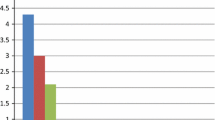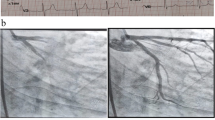Abstract
Background
Slow coronary flow (SCF) is an angiographic finding characterized by delayed opacification of the epicardial coronary arteries without obstructive coronary disease. Resistin, an adipocytokine, plays a major role besides low-grade inflammation in atherosclerotic vascular processes and may be of importance in other coronary pathologies such as SCF.
Methods
The present study was cross-sectional and observational, consisting of 70 individuals who underwent coronary angiography and had angiographically normal coronary arteries of varying coronary flow rates. The study included 50 patients with isolated SCF and 20 control participants with normal coronary flow (NCF).
Results
There were no statistically significant differences between the SCF and NCF groups with respect to age, gender, presence of hypertension or diabetes mellitus, and smoking habit, except for increased creatinine levels (p = 0.014). The serum resistin level was significantly higher in the SCF group than in the NCF group (8.4 ± 7.2 vs. 5.4 ± 2.6 ng/ml, p = 0.014). Ln-transformed resistin levels correlated positively with left anterior descending (LAD) coronary artery TIMI frame count (TFC) (r = 0.408, p < 0.001) as well as with glucose (r = 0.340, p = 0.004), creatinine (r = 0.248, p = 0.044), and C-reactive protein (CRP; r = 0.283, p = 0.023) levels, and negatively with LAD coronary flow velocity (r = − 0.314, p = 0.009). When multivariate analyses were performed, in linear regression analysis, ln-resistin was associated with a longer TFC [beta (standardized regression coefficient): 0.404, p = 0.001] and lower coronary flow velocity (beta: − 0.280, p = 0.035); in logistic regression analysis, ln-resistin was an independent predictor of the presence of SCF (OR: 6.692, 65 %CI: 1.117–40.1, p = 0.037).
Conclusion
We demonstrated, for the first time, a significant increase in serum resistin levels in patients with SCF compared to subjects with NCF. We believe that further studies are needed to clarify the role of resistin in patients with SCF.
Zusammenfassung
Hintergrund
Ein langsamer Koronarfluss (“slow coronary flow”, SCF) ist ein Angiographiebefund, der durch eine verzögerte Darstellung der epikardialen Koronararterien ohne obstruktive Koronarerkrankung gekennzeichnet ist. Resistin, ein Adipozytokin, spielt neben leichtgradigen Entzündungsprozessen eine wesentliche Rolle bei der Gefäßatherosklerose und kann auch bei anderen pathologischen Veränderungen der Koronarien wie dem SCF von Bedeutung sein
Methoden
Die vorliegende Querschnitts- und Beobachtungsstudie umfasst 70 Teilnehmer, bei denen eine Koronarangiographie durchgeführt wurde, in welcher sich die Koronararterien mit unterschiedlichen Koronarflussraten normal darstellten. In die Studie aufgenommen wurden 50 Patienten mit isoliertem SCF und 20 Teilnehmer mit normalem Koronarfluss („normal coronary flow“, NCF) als Kontrollen.
Ergebnisse
Es gab keine statistisch signifikanten Unterschiede zwischen SCF und NCF bezüglich Alter, Geschlecht, Vorliegen einer Hypertonie oder eines Diabetes mellitus und Rauchgewohnheiten bis auf erhöhte Kreatininwerte (p = 0,014). Der Serumresistinspiegel war in der SCF-Gruppe signifikant höher als in der NCF-Gruppe (8,4 ± 7,2 vs. 5,4 ± 2,6 ng/ml; p = 0,014). Die logarithmisch transformierten (Ln-)Resistinspiegel korrelierten positiv mit dem TIMI Frame Count (“thrombolysis in myocardial infarction frame count”, TFC) des Ramus interventricularis anterior (RIVA; r = 0,408; p < 0,001), Glukose (r = 0,340; p = 0,004), Kreatinin (r = 0,248; p = 0,044), CRP (r = 0,283; p = 0,023) und negativ mit der Koronarflussgeschwindigkeit des RIVA (r = − 0,314; p = 0,009). Bei der Durchführung multivariater Analysen ging in der linearen Regressionsanalyse Ln-Resistin mit höherem TFC [Beta (standardisierter Regressionskoeffizient): 0,404; p = 0,001) und geringerer Koronarflussgeschwindigkeit (Beta: − 0,280; p = 0,035) einher, und es war in der logistischen Regressionsanalyse ein unabhängiger Prädiktor des Vorliegens eines SCF (Odds Ratio: 6,692; 65 %-KI: 1,117–40,1; p = 0,037).
Schlussfolgerung
Erstmals wurde ein signifikanter Anstieg des Serumresistinspiegels bei Patienten mit SCF im Vergleich zu Personen mit NCF gezeigt. Weitere Studien sind unseres Erachtens erforderlich, um die Rolle von Resistin bei Patienten mit SCF zu klären.


Similar content being viewed by others
References
Tambe AA, Demany MA, Zimmerman HA, Mascarenhas E (1972) Angina pectoris and slow flow velocity of dye in coronary arteries—a new angiographic finding. Am Heart J 84:66–71
Goel PK, Gupta SK, Agarwal A, Kapoor A (2001) Slow coronary flow: a distinct angiographic subgroup in syndrome X. Angiology 52:507–514
Mangieri E, Macchiarelli G, Ciavolella M et al (1996) Slow coronary flow: clinical and histopathological features in patients with otherwise normal epicardial coronary arteries. Cathet Cardiovasc Diagn 37:375–381
Cin VG, Pekdemir H, Camsar A et al (2003) Diffuse intimal thickening of coronary arteries in slow coronary flow. Jpn Heart J 44:907–919
Sezgin AT, Sigirci A, Barutcu I et al (2003) Vascular endothelial function in patients with slow coronary flow. Coron Artery Dis 14:155–161
Riza Erbay A, Turhan H, Yasar AS et al (2005) Elevated level of plasma homocysteine in patients with slow coronary flow. Int J Cardiol 102:419–423
Mosseri M, Yarom R, Gotsman MS, Hasin Y (1986) Histologic evidence for small-vessel coronary artery disease in patients with angina pectoris and patent large coronary arteries. Circulation 74:964–972
Lyon CJ, Law RE, Hsueh WA (2003) Minireview: adiposity, inflammation, and atherogenesis. Endocrinology 144:2195–2200
Fragasso G, Chierchia SL, Arioli F et al (2009) Coronary slow-flow causing transient myocardial hypoperfusion in patients with cardiac syndrome X: long-term clinical and functional prognosis. Int J Cardiol 137:137–144
Tan KC, Xu A, Chow WS et al (2004) Hypoadiponectinemia is associated with impaired endothelium-dependent vasodilation. J Clin Endocrinol Metab 89:765–769
Dick GM, Katz PS, Farias M et al (2006) Resistin impairs endothelium-dependent dilation to bradykinin, but not acetylcholine, in the coronary circulation. Am J Physiol Heart Circ Physiol 291:H2997–H3002
Gibson CM, Cannon CP, Daley WL et al (1996) TIMI frame count: a quantitative method of assessing coronary artery flow. Circulation 93:879–888
Kurtoglu N, Akcay A, Dindar I (2001) Usefulness of oral dipyridamole therapy for angiographic slow coronary artery flow. Am J Cardiol 87:777–779, A8
Pekdemir H, Polat G, Cin VG et al (2004) Elevated plasma endothelin-1 levels in coronary sinus during rapid right atrial pacing in patients with slow coronary flow. Int J Cardiol 97:35–41
De Bruyne B, Hersbach F, Pijls NH et al (2001) Abnormal epicardial coronary resistance in patients with diffuse atherosclerosis but“Normal” coronary angiography. Circulation 104:2401–2406
Li JJ, Xu B, Li ZC et al (2006) Is slow coronary flow associated with inflammation? Med Hypotheses 66:504–508
Turhan H, Saydam GS, Erbay AR et al (2006) Increased plasma soluble adhesion molecules; ICAM-1, VCAM-1, and E-selectin levels in patients with slow coronary flow. Int J Cardiol 108:224–230
Lanza GA, Andreotti F, Sestito A et al (2001) Platelet aggregability in cardiac syndrome X. Eur Heart J 22:1924–1930
Gökçe M, Kaplan S, Tekelioğlu Y et al (2005) Platelet function disorder in patients with coronary slow flow. Clin Cardiol 28:145–148
Camsarl A, Pekdemir H, Çicek D et al (2003) Endothelin- 1 and nitric oxide concentrations and their response to exercise in patients with slow coronary flow. Circ J 67:1022–1028
Pekdemir H, Polat G, Cin VG et al (2004) Elevated plasma endothelin-1 levels in coronary sinus during rapid right atrial pacing in patients with slow coronary flow. Int J Cardiol 97:35–41
Yıldız A, Gür M, Yılmaz R et al (2008) Association of paraoxonase activity and coronary blood flow. Atherosclerosis 197:257–263
Enli Y, Türk M, Akbay R et al (2008) Oxidative stress parameters in patients with slow coronary flow. Adv Ther 25:37–44
Reilly MP, Lehrke M, Wolfe ML et al (2005) Resistin is an inflammatory marker of atherosclerosis in humans. Circulation 111:932–939
Burnett MS, Lee CW, Kinnaird TD et al (2005) The potential role of resistin in atherogenesis. Atherosclerosis 182:241–248
Lubos E, Messow C, Schnabel R et al (2007) Resistin, acute coronary syndrome and prognosis results from the AtheroGene study. Atherosclerosis 193:121–128
Verma S, Li SH, Wang CH et al (2003) Resistin promotes endothelial cell activation: further evidence of adipokine-endothelial interaction. Circulation 108:736–740
Kawanami D, Maemura K, Takeda N et al (2004) Direct reciprocal effects of resistin and adiponectin on vascular endothelial cells: a new insight into adipocytokine- endothelial cell interactions. Biochem Biophys Res Commun 314:415–419
Calabro P, Samudio I, Willerson JT (2004) Resistin promotes smooth muscle cell proliferation through activation of extra cellular signal regulated kinase ½ and phosphatidylinositol 3-kinase pathways. Circulation 110:3335–3340
Arı H, Arı S, Erdoğan E et al (2010) The effects of endothelial dysfunction and inflammation on slow coronary flow. Turk Kardiyol Dern Ars 38:327–333
Dick GM, Katz PS, Farias M III et al (2006) Resistin impairs endothelium-dependent dilation to bradykinin, but not acetylcholine, in the coronary circulation. Am J Physiol Heart Circ Physiol 291:H2997–H3002
Yildiz A, Sezen Y, Gur M et al (2008) Impact of renal dysfunction on coronary blood flow. J Harran Univ Med Fac 5(2):11–18
Conflict of interest
On behalf of all authors, the corresponding author states that there are no conflicts of interest.
Author information
Authors and Affiliations
Corresponding author
Rights and permissions
About this article
Cite this article
Çanga, A., Çetin, M., Kocaman, S. et al. Increased serum resistin levels in patients with coronary slow-flow phenomenon. Herz 38, 773–778 (2013). https://doi.org/10.1007/s00059-013-3758-6
Received:
Revised:
Accepted:
Published:
Issue Date:
DOI: https://doi.org/10.1007/s00059-013-3758-6




